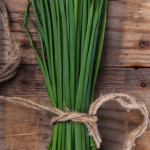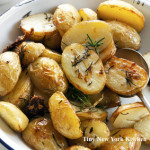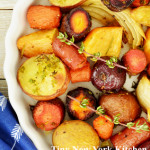Crunchy, juicy, nutrient packed jicama is an unsung hero of the produce aisle. Technically a cousin to green beans, jicama is a root vegetable from Mexico available year-round that is delicious cooked or raw. With a mild, earthy, slightly sweet flavor and an apple like consistency. It’s a great addition to salads, salsas, slaws, and grazing boards. Jicama also works as lighter swap for potatoes in baked and air fried recipes, and it’s delicious sautéed or boiled, too.
If you’ve never tried jicama, don’t be intimidated. Start by choosing one with a smooth, unblemished surface and thin brown skin. The skin should be thin enough to scrape with your thumbnail to reveal the white flesh inside. Avoid thick skinned, bruised, or shriveled jicama, which are signs of aging.
Once you’re ready to prep, start by trimming off the ends of the jicama and slice in half. Then, use a knife to gently peel away the skin.
For Jicama Sticks:
Step 1: Carefully slice off the rounded parts of the jicama, creating a flat surface.
Step 2: Cut each half into 1/4-inch slices.
Step 3: Stack slices and cut evenly into sticks.
Fresh, raw jicama sticks are a great addition to lunchboxes or served on a vegetable platter with your favorite dip. They can also add unexpected, satisfying crunch to cooked dishes, like a noodle salad with jicama and a miso vinaigrette.
Jicama sticks are delicious roasted, too. Their firm texture can withstand the heat, while the edges get golden brown and tender. Toss together with sweet peppers and spices for a simple, satisfying sheet pan side that pairs well with all kinds of meat and fish.
For Diced Jicama:
Step 1: Follow the steps above to create jicama sticks
Step 2: Line up sticks or stack into a pile, then evenly cut into cubes.
Diced jicama is a vitamin and fiber-rich way to add bulk to all kinds of green, grain, and protein-based salads. I love the combination of crunchy jicama with creamy avocado served with grilled chicken.
Moist and mild flavored jicama also plays well with fruit, especially melon. A refreshing combination of watermelon, jicama, and fresh mint falls somewhere between salad and salsa, delicious scooped onto tortilla chips or just spooned straight from the bowl.
Next time you’re at your local grocery store or market pick up jicama and experiment with ways to incorporate it into your recipes.
©Tiny New York Kitchen © 2021 All Rights Reserved
Sweet potatoes are available year-round, but their true seasons are fall and winter.
When selecting choose firm, unblemished sweet potatoes without any breaks in their thin skin.
Preparing: To bake whole sweet potatoes, scrub them well first and prick their skins in a few places with a fork. Place them on a baking sheet to catch their juices, and bake in a preheated 400-degree oven until they are tender when pierced with a knife, about 45 minutes. They may then be peeled and sliced or cut into chunks for glazing, or puréed. You can also peel uncooked sweet potatoes and cook them in salted boiling water until tender before glazing or pureeing.
Sweet potatoes do not keep well. Store them in a cool, dark place, but plan to use them within a week or so.
©Tiny New York Kitchen © 2020 All Rights Reserved
As gardens begin to grow, one of the first perennial herbs to appear are chives. Chives are quite resilient and are particularly easy to grow both in garden beds or in pots. They can stand a bit of shade, tolerate drought, and grow well in any type of garden soil. For first time gardeners, this is an excellent plant that will yield a reliable source of flavorful nutrition.
Chives belong to the lily family and are part of a large genus of over 500 species of perennials that contain bulbs or underground stems. Known for their strong scent and distinct flavor, chives, along with garlic, onions, scallions and leeks are known as allium herbs. Allium species have been cultivated around the world for centuries and are valued both medicinally ad for their fabulous flavor.
If you grow your own chives, you can continually cut them back so the crop will continue into early fall. If you let happen to let them go you will get lovely purple-pink globe shaped chive flowers that make a beautiful garnish as well as a bright addition to spring or summer salads.
Chives are best when used fresh. Rinse and dry them well, then snip with scissors or cut with a very sharp knife. Snipped chives can be placed in freezer bags and frozen for later use, but will not maintain the texture of fresh shoots.
This is an herb that will elevate so many dishes, including soups, stews, salads, sauces, marinades, dressings, and dips. Adding a few tablespoons of chopped chives to cottage cheese will add a pleasing punch to a super simple snack. Make an easy supper of baked potatoes or sweet potatoes topped with Greek yogurt and chives. Mixing chives into cream cheese, along with lemon zest, and a grinding of black pepper will make an excellent spread for sandwiches or crackers. Omelets prepared with chives, parsley, and dill are a nice choice for any meal.
Chives contain valuable vitamin and mineral content. Vitamins K, A, and C are found in chives, as well as calcium, an important mineral. Chives also contain small amounts of magnesium, phosphorus, potassium, and sodium. Purported to be anti-inflammatory, antibacterial and antiviral, eating more chives may boost your immune system and assist in maintaining superior levels of health.
If you buy your own chives at the grocery store, look for a bright green color with no sign of yellowing or wilting. Chives will keep in the crisper drawer of the refrigerator for several days. Before using, rinse and dry well and trim the ends before using.
Enjoy this light and bright spring herb.
“Work With What You Got!”
©Tiny New York Kitchen © 2020 All Rights Reserved
These freezer essentials will help you with your weekly meal prep as well as last minute meals that you need to get on the table fast.
Bagged frozen vegetables, like mixed peppers, broccoli, and spinach.
Bagged frozen fruit, like blueberries, mangos, bananas, and strawberries.
Bagged frozen pastas, like tortellini and ravioli.
Frozen waffles and pancakes.
Frozen potatoes, like tots, fries, and breakfast potatoes.
Rice and prepared side dishes.
Pre-made dough, pie crusts, and breads.
Frozen foods are not limited to frozen dinners. You can stock your freezer with healthier ingredients to make putting dinner together easy. There are endless possibilities with what you can make with frozen ingredients. As always, be creative and “work with what you got!”
“Work With What You Got!”
©Tiny New York Kitchen © 2020 All Rights Reserved
I don’t know what’s more comforting than potatoes. A staple food in many parts of the world, potatoes are an integral part of much of the world’s food supply. Potatoes are the world’s fourth-largest food crop after maize, wheat, and rice.
There are currently over 1,000 different types of potatoes.
White Potatoes: These all-purpose potatoes are moderately starchy with a dense, creamy texture and can be roasted, baked, boiled, or steamed.
Russet Potatoes: Starchy and fluffy, these potatoes are ideal for mashing and baking, as well as French fries and latkes.
Fingerling Potatoes: Small, knobby fingerlings have thin, delicate skin that doesn’t need to be peeled. Their firm texture stands up to roasting, boiling, and pan-frying.
Baby Potatoes: Also known as new potatoes, these tiny potatoes come in a rainbow of colors (another reason to leave the skin on). They are best cooked whole and boiled, steamed, or roasted.
Gold Potatoes: These thin-skinned potatoes (also called yellow potatoes) are beloved for their buttery flesh. They’re fluffy enough to be smashed yet firm enough to be used in soup or stew.
Red Potatoes: Ruby skin gives these potatoes visual appeal, and their firm and waxy texture means they soak up flavor without turning too soft. They are ideal for salads and gratins.
Look for potatoes without any bruises, cuts, wrinkles, or soft spots, which can all be signs of age or poor handling. If they smell like soil, that’s typically an indication of freshness. While fresh is best, potatoes keep for quite some time. Store them in a spot that’s cool, dark, and dry. If eyes sprout, simply cut them off and use the potatoes as normal. Potatoes provide vitamins C and B6, plus iron and potassium. While the whole potato contains fiber, you will get an extra boost if you leave the skin on.
“Work With What You Got!”
©Tiny New York Kitchen © 2019 All Rights Reserved
To flavor your food reach for herbs and spices rather than high-sodium table salt. Make sure to read the labels of seasoning mixes because many of them contain salt.
Seasoning Suggestions
Pasta: Basil, Fennel, Garlic, Paprika, Parsley, Sage
Potatoes: Chives, Garlic, Paprika, Parsley, Rosemary
Rice: Cumin, Marjoram, Parsley, Saffron, Tarragon, Thyme, Turmeric
Seafood: Chervil, Dill, Fennel, Tarragon, Parsley
Vegetables: Basil, Caraway, Chives, Dill, Marjoram, Mint, Nutmeg, Oregano, Paprika, Rosemary, Savory, Tarragon, Thyme
“Work With What You Got!”
©Tiny New York Kitchen © 2019 All Rights Reserved
This fall Tiny New York Kitchen celebrates sweet parsnips, earthy beets, and mild turnips. These root vegetables offer flavor, nutrition, and versatility.
Look for root vegetables that are firm to the touch with smooth, blemish-free skin. If there are any greens attached, make sure they look fresh, not wilted.
Before storing parsnips, beets, and turnips, remove any greens and brush off any dirt. Wrap in a damp paper towel, place in a plastic bag, and store in the refrigerator crisper; most roots will last up to two weeks.
Root vegetables absorb nutrients from the soil they grow in, including antioxidants, iron, and vitamins A, B, and C. They also provide fiber, which helps you feel fuller longer. To maximize your fiber intake, leave the skin on and give parsnips and carrots a good scrub instead.
Parsnips: These pale, carrot-like root vegetables are sweet and earthy. They can be roasted, sautéed, mashed, and puréed. Choose small to medium parsnips, since larger ones can be woody.
Beets: Beets can be red, golden, or striped. Whether roasted, boiled, or steamed, they’re slow to cook, but packaged precooked versions are also an option. You can even enjoy beets raw. Simply peel and grate or thinly slice.
Turnips: Creamy white with pinkish-purple tops, turnips turn mellow and tender when cooked. Try them roasted, sautéed, mashed, or added to soups and stews.
Greens: If you’re lucky, your beets and turnips will have greens attached. These edible, nutritious, and delicious greens should always be removed for storage, as they pull moisture from the root ends. Wash the greens and use to make pesto, or sauté with garlic and oil for a quick side dish or simple pasta.
“Work With What You Got!”
©Tiny New York Kitchen © 2018 All Rights Reserved
Beautiful autumn! The tapestry of autumn is tinged with splendor, as nature sheds its robe of green and garbs itself in the richly textured colors of fall. As leaves begin to turn deep shades of burnt orange, russet, gold, umber burgundy, cooks seek out lavish and luscious seasonal ingredients.
Apples
Pears
Cranberries
Persimmons
Pomegranates
Cabbage
Rutabaga
Turnips
Cauliflower
Beets
Sweet potatoes
Pumpkins
Squash
“Work With What You Got!”
©Tiny New York Kitchen © 2018 All Rights Reserved















